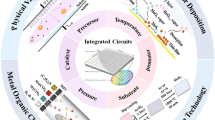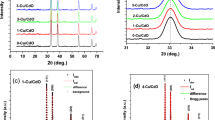Abstract
From thin film solar cells to metal–oxide–semiconductor (MOS) devices in leading edge integrated circuits, the electronic structure at and near the interfaces between component materials determines the most important fundamental operating characteristics of those devices such as turn-on voltage, power dissipation, and off-state current leakage. Fermi level location at buried interfaces, semiconductor (SC) band bending, charge transfer, oxide defects, and work functions of the constituent materials all contribute to device performance. This paper describes how these important parameters can be determined by employing femtosecond photovoltage spectroscopy, an extension of ultraviolet photoelectron spectroscopy (UPS) using ultrafast lasers. While standard UPS is fundamentally a surface-sensitive spectroscopy, pump/probe techniques add a new dimension to this venerable spectroscopy, permitting the accurate extraction of the underlying band bending in SCs. When combined with the valence band edge location of the SC and oxide, and determination of the system Fermi level, full characterization of the electronic structure of a MOS stack can be obtained providing key insights on device operating properties. This approach can be extended to study key device materials in emerging areas of artificial intelligence and quantum computing. In each case, surprising new details were uncovered that led to performance optimization of these technologically important devices.






Similar content being viewed by others
References
E.W. Plummer and W. Eberhardt: Angle-resolved photoemission as a tool for the study of surfaces. Adv. Chem. Phys. 49, 533–656 (2007).
M.P. Seah and W.A. Dench: Quantitative electron spectroscopy of surfaces: A standard data base for electron inelastic mean free paths in solids. Surf. Interface Anal. 1, 2–11 (1979).
J.L. Krause, K.J. Schafer, and K.C. Kulander: High-order harmonic generation from atoms and ions in the high intensity regime. Phys. Rev. Lett. 68, 3535–3538 (1992).
R.A. Bartels, A. Paul, H. Green, H.C. Kapteyn, M.M. Murnane, S. Backus, I.P. Christov, Y. Liu, D. Attwood, and C. Jacobsen: Generation of spatially coherent light at extreme ultraviolet wavelengths. Science 297, 376–378 (2002).
S. Backus, J. Peatross, C.P. Huang, M.M. Murnane, and H.C. Kapteyn: Ti: Sapphire amplifier producing millijoule-level, 21-fs pulses at 1 kHz. Opt. Lett. 20, 2000–2002 (1995).
C.G. Durfee, III, A.R. Rundquist, S. Backus, C. Herne, M.M. Murnane, and H.C. Kapteyn: Phase matching of high-order harmonics in hollow waveguides. Phys. Rev. Lett. 83, 2187 (1999).
T. Popmintchev, M.-C. Chen, P. Arpin, M.M. Murnane, and H.C. Kapteyn: The attosecond nonlinear optics of bright coherent X-ray generation. Nat. Photon. 4, 822–832 (2010).
R. Haight and D.R. Peale: Antibonding state on the Ge (111): As surface: Spectroscopy and dynamics. Phys. Rev. Lett. 70, 3979 (1993).
R. Haight: Electron dynamics at surfaces. Surf. Sci. Rep. 21, 275–325 (1995).
A. Gauthier, J.A. Sobota, N. Gauthier, K.J. Xu, H. Pfau, C. Rotundu, Z.X. Shen, and P.S. Kirchmann: Tuning time and energy resolution in time-resolved photoemission spectroscopy. arXiv Prepr arXiv200607758 (2020).
Y. van de Burgt, E. Lubberman, E.J. Fuller, S.T. Keene, G.C. Faria, S. Agarwal, M.J. Marinella, A.A. Talin, and A. Salleo: A non-volatile organic electrochemical device as a low-voltage artificial synapse for neuromorphic computing. Nat. Mater. 16, 414 (2017).
M. Gloeckler and J.R. Sites: Efficiency limitations for wide-band-gap chalcopyrite solar cells. Thin Solid Films 480–481, 241–245 (2005).
R. Noufi and K. Zweibel: High-efficiency CdTe and CIGS thin-film solar cells: Highlights and challenges. In 2006 IEEE 4th World Conference on Photovoltaic Energy Conference, Waikoloa, HI, 2006; pp. 317–320. doi: https://doi.org/10.1109/WCPEC.2006.279455.
M. Dhanam, R.R. Prabhu, and P.K. Manoj: Investigations on chemical bath deposited cadmium selenide thin films. Mater. Chem. Phys. 107, 289–296 (2008).
Y. Tauchi, K. Kim, H. Park, and W. Shafarman: Characterization of (AgCu)(InGa)Se2absorber layer fabricated by a selenization process from metal precursor. IEEE J. Photovolt. 3, 467–471 (2013).
L.M. Mansfield, R. Noufi, C.P. Muzzillo, C. Dehart, K. Bowers, B. To, J.W. Pankow, R.C. Reedy, and K. Ramanathan: Enhanced performance in Cu(In,Ga)Se2 solar cells fabricated by the two-step selenization process with a potassium fluoride postdeposition treatment. IEEE J. Photovolt. 4, 1650–1654 (2014).
C. Platzer-Björkman, T. Törndahl, D. Abou-Ras, J. Malmström, J. Kessler, and L. Stolt: Zn(O,S) buffer layers by atomic layer deposition in Cu(In,Ga)Se2 based thin film solar cells: Band alignment and sulfur gradient. J. Appl. Phys. 100, 044506 (2006).
W. Wang, M.T. Winkler, O. Gunawan, T. Gokmen, T.K. Todorov, Y. Zhu, and Y.Z. Mitzi: Device characteristics of CZTSSe thin-film solar cells with 12.6% efficiency. Adv. Energy Mater. 4, 1–5 (2014).
R. Haight, A. Barkhouse, O. Gunawan, B. Shin, M. Copel, M. Hopstaken, and D.B. Mitzi: Band alignment at the Cu2ZnSn(SxSe1–x)4/CdS interface. Appl. Phys. Lett. 98, 253502 -1–3 (2011).
W. Ki and W.H. Hillhouse: Earth-abundant element photovoltaics directly from soluble precursors with high yield using a non-toxic solvent. Adv. Energy Mater. 15, 732–735 (2011).
H. Paik, D.I. Schuster, L.S. Bishop, G. Kirchmair, G. Catelani, A.P. Sears, B.R. Johnson, M.J. Reagor, L. Frunzio, L.I. Glazman, and S.M. Girvin: Observation of high coherence in Josephson junction qubits measured in a three-dimensional circuit QED architecture. Phys. Rev. Lett. 107, 240501 (2011).
R. McDermott: Materials origins of decoherence in superconducting qubits. IEEE Trans. Appl. Supercond. 19, 2 (2009).
D. Lim, R. Haight, M. Copel, and E. Cartier: Oxygen defects and Fermi level location in metal-hafnium oxide-silicon structures. Appl. Phys. Lett. 87, 72902 (2005).
J.A. del Alamo: Nanometre-scale electronics with III–V compound semiconductors. Nature 479, 317 (2011).
E.A. Gibson, A. Paul, N. Wagner, D. Gaudiosi, S. Backus, I.P. Christov, A. Aquila, E.M. Gullikson, D.T. Attwood, M.M. Murnane, and H.C. Kapteyn: Coherent soft X-ray generation in the water window with Quasi-phase matching. Science 302, 95 (2003).
M. Lewenstein, P. Balcou, M.Y. Ivanov, A. L’huillier, and P.B. Corkum: Theory of high-harmonic generation by low-frequency laser fields. Phys. Rev. A 49, 2117 (1994).
R. Haight and A.V. Carr: Industrial Applications of Ultrafast Lasers. 1st ed. (World Scientific Press, London, Singapore, 2018). ISBN 2335-6596 v. 11.
D. Lim and R. Haight: In situ photovoltage measurements using femtosecond pump-probe photoelectron spectroscopy and its application to metal–HfO2–Si structures. J. Vac. Sci. Technol. A 23, 1698–1705 (2005).
H. Carstens, M. Högner, T. Saule, S. Holzberger, N. Lilienfein, A. Guggenmos, C. Jocher, T. Eidam, D. Esser, V. Tosa, V. Pervak, J. Limpert, A. Tünnermann, U. Kleineberg, F. Krausz, and I. Pupeza: High-harmonic generation at 250 MHz with photon energies exceeding 100 eV. Optica 3, 366 (2016).
S.M. Sze and K.K. Ng: Physics of Semiconductor Devices (John Wiley & Sons, New Jersey, US, 2006).
E.A. Kraut, R.W. Grant, J.R. Waldrop, and S.P. Kowalczyk: Precise determination of the valence-band edge in x-ray photoemission spectra: Application to measurement of semiconductor interface potentials. Phys. Rev. Lett. 44, 1620 (1980).
S.A. Chambers, T. Droubay, T.C. Kaspar, and M. Gutowski: Experimental determination of valence band maxima for SrTiO3, TiO2, and SrO and the associated valence band offsets with Si (001). J. Vac. Sci. Technol. B 22, 2205–2215 (2004).
D. Lim and R. Haight: Temperature dependent defect formation and charging in hafnium oxides and silicates. J. Vac. Sci. Technol. B 23, 201–205 (2005).
O.A. Dicks, J. Cottom, A.L. Shluger, and V Afanasiev: The origin of negative charging in amorphous Al2O3 films: The role of native defects. Nanotechnology 30, 205201 (2019).
D.J. Frank, E. Nowak, and P.M. Solomon: Device scaling limits of Si MOSFETs and their application dependencies. Proc. IEEE 89, 259 (2001).
R. Haight, A. Barkhouse, O. Gunawan, B. Shin, M. Copel, M. Hopstaken, and D.B. Mitzi: Band alignment at the Cu2ZnSn (SxSe1−x)4/CdS interface. Appl. Phys. Lett. 98, 253502 (2011).
R. Haight, T. Gershon, O. Gunawan, P. Antunez, D. Bishop, Y.S. Lee, T. Gokman, K. Sardashti, E. Chagarov, and A. Kummel: Industrial perspectives on earth abundant, multinary thin film photovoltaics. Semicond. Sci. Technol. 32, 033004 (2017).
T. Minemoto, Y. Hashimoto, T. Satoh, T. Negami, H. Takakura, and Y. Hamakawa: Cu(In,Ga)Se[sub 2] solar cells with controlled conduction band offset of window/Cu(In,Ga)Se2 layers. J. Appl. Phys. 89, 8327 (2001).
D.A.R. Barkhouse, R. Haight, N. Sakai, H. Hiroi, H. Sugimoto, and D.B. Mitzi: Cd-free buffer layer materials on Cu2ZnSn(SxSe1-x)4: Band alignments with ZnO, ZnS, and In2S3. Appl. Phys. Lett. 100, 4–9 (2012).
R. Haight, A. Barkhouse, W. Wang, Y. Luo, X. Shao, D.B. Mitzi, H. Homare, and S. Sugimoto: CdS and Cd-free buffer layers on solution phase grown Cu2ZnSn (SxSe1−x)4: Band alignments and electronic structure determined with femtosecond ultraviolet photoelectron spectroscopy. In MRS Proceedings, Vol. 1638 (Cambridge University Press, Cambridge, UK, 2014) p. mrsf13–1638.
J. Li, M. Wei, Q. Du, W. Liu, G. Jiang, and C. Zhu: The band alignment at CdS/Cu2ZnSnSe4 heterojunction interface. Surf. Interface Anal. 45, 682–684 (2013).
M. Bär, B.A. Schubert, B. Marsen, R.G. Wilks, S. Pookpanratana, M. Blum, S. Krause, T. Unold, W. Yang, L. Weinhardt, and C. Heske: Cliff-like conduction band offset and KCN-induced recombination barrier enhancement at the CdS/Cu2ZnSnS4 thin-film solar cell heterojunction. Appl. Phys. Lett. 99, 222105 (2011).
A. Barinov, P. Dudin, L. Gregoratti, A. Locatelli, T.O. Menteş, M.A. Nino, and M. Kiskinova: Synchrotron-based photoelectron microscopy. Nucl. Instrum. Methods Phys. Res. A 601, 195–2002 (2009).
Acknowledgment
The work on earth-abundant CZTS,Se thin film photovoltaics was supported by DoE FPACEII funding under Contract No. DE-EE-0006334.
Author information
Authors and Affiliations
Corresponding author
Rights and permissions
About this article
Cite this article
Haight, R. Electronic structure of technologically important interfaces and heterostructures. MRS Communications 10, 529–537 (2020). https://doi.org/10.1557/mrc.2020.63
Received:
Accepted:
Published:
Issue Date:
DOI: https://doi.org/10.1557/mrc.2020.63




